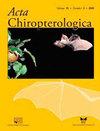尼日利亚隐藏的非洲热带蝙蝠多样性:来自生物多样性热点的10项新的国家记录
IF 0.7
4区 生物学
Q4 ZOOLOGY
引用次数: 2
摘要
由于采样技术效率低下、调查工作有限和分类学描述,隐性多样性阻碍了对非洲蝙蝠多样性的了解。尼日利亚记录了90种蝙蝠,支持了非洲已知蝙蝠多样性的近三分之一,但该国的样本仍然相对不足。尼日利亚东南部和喀麦隆西南部预计将成为非洲六个蝙蝠多样性热点中最大的一个,喀麦隆方面将接受更多的采样工作。这一地区也被认为支持高度多样化的哺乳动物群落和特有物种。尽管如此,该蝙蝠多样性热点尼日利亚部分的两个主要保护区迄今尚未进行采样,这增加了在这些优先保护森林中发现新的国家记录的可能性。我们在阿飞山野生动物保护区和克罗斯河国家公园(Okwangwo分区)的森林中使用竖琴陷阱和雾网进行了深入调查。我们还记录了被捕获个体的回声定位呼叫,创建了第一个国内呼叫库。我们捕获了36种蝙蝠,其中10种是新的国家记录,使尼日利亚已知的蝙蝠物种数量增至100种。捕捉到的哈普陷阱蝙蝠占森林下层蝙蝠样本的99%,18种蝙蝠中有15种完全被陷阱捕获。捕获物的稀疏曲线表明,使用竖琴捕捉器进行的采样接近完全,但使用雾网进行的采样不完全。在10项新的国家记录中,有8项是在竖琴陷阱中捕捉到的,这表明了当代技术对经常被遗漏的物种的价值——这里被称为方法盲点多样性。我们报告了对两个博物馆标本的重新鉴定,这两个标本以前被鉴定为Rhinolophus hillorum(R.cf.hillorum)和Miniopterus inflattus(M.villiersi)。因此,我们对真实形态的捕捉首次证实了这两个物种在尼日利亚的存在。我们还对其他物种提供了值得注意的分类学评论。为了提高未来非洲萎缩性蝙蝠调查的效率,我们建议在已确定的多样性热点地区,特别是采样不足的地点,部署补充诱捕技术。本文章由计算机程序翻译,如有差异,请以英文原文为准。
Hidden Afrotropical Bat Diversity in Nigeria: Ten New Country Records from a Biodiversity Hotspot
Knowledge of Afrotropical bat diversity is hindered by hidden diversity because of inefficient sampling techniques, limited survey effort, and taxonomic description. With 90 bat species recorded, Nigeria supports almost a third of the bat diversity known to occur in Africa, yet the country remains relatively under-sampled. Southeastern Nigeria and southwestern Cameroon are predicted to be the largest of six bat diversity hotspots in Africa, with the Cameroonian side receiving more sampling effort. This area is also recognized to support hyperdiverse mammalian assemblages and endemic species. Notwithstanding, two major protected areas on the Nigerian part of this bat diversity hotspot were hitherto not sampled, raising the likelihood of discovering new country records in these conservation priority forests. We conducted an intensive survey using harp traps and mist nets in forests of Afi Mountain Wildlife Sanctuary and Cross River National Park (Okwangwo Division). We also recorded echolocation calls of captured individuals to create the first in-country call library. We captured 36 bat species of which 10 are new country records raising the number of bat species known from Nigeria to 100. Harp trap captures represented 99% of forest understory bats sampled with 15 out of 18 species caught exclusively in traps. Rarefaction curves of captures suggest near-complete sampling with harp traps but incomplete sampling with mist nets. Eight of the 10 new country records were captured exclusively in harp traps, demonstrating the value of contemporary techniques for frequently missed species — here referred to as methodological blind-spot diversity. We report the re-identification of two museum specimens that were previously identified as Rhinolophus hillorum (R. cf. hillorum) and Miniopterus inflatus (M. villiersi) thus, our captures of the true forms confirm the presence of both species in Nigeria for the first time. We also provide noteworthy taxonomic comments on other species. To improve the efficiency of future Afrotropical bat surveys we recommend the deployment of complementary trapping techniques in identified diversity hotspots, especially sites that have been under-sampled.
求助全文
通过发布文献求助,成功后即可免费获取论文全文。
去求助
来源期刊

Acta Chiropterologica
生物-动物学
CiteScore
2.50
自引率
20.00%
发文量
42
审稿时长
>12 weeks
期刊介绍:
Acta Chiropterologica, published by the Museum and Institute of Zoology at the Polish Academy of Sciences, is devoted solely to the study and discussion of bats.
 求助内容:
求助内容: 应助结果提醒方式:
应助结果提醒方式:


